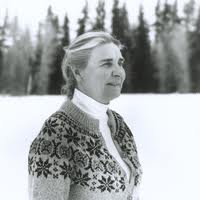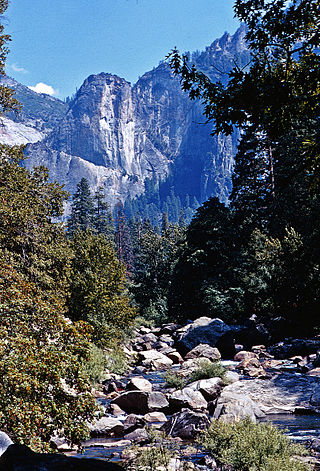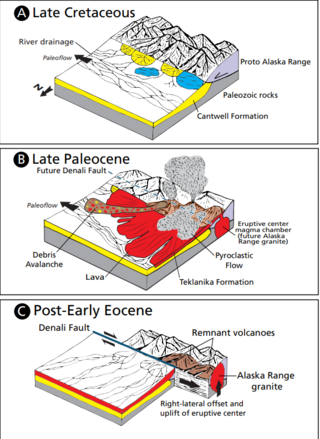
The Arctic National Wildlife Refuge or Arctic Refuge is a national wildlife refuge in northeastern Alaska, United States, on traditional Gwich'in lands. The refuge is 19,286,722 acres (78,050.59 km2) of the Alaska North Slope region, with a northern coastline and vast inland forest, taiga, and tundra regions. ANWR is the largest national wildlife refuge in the country, slightly larger than the Yukon Delta National Wildlife Refuge. The refuge is administered from offices in Fairbanks. ANWR is home to a diverse range of endemic mammal species; notably, it is one of the few North American locations with all three endemic American ursids—the polar bear, grizzly bear, and American black bear, each of which resides predominantly in its own ecological niche. Besides the bears, other mammal species include the moose, caribou, wolves, red and Arctic fox, Canada lynx, wolverine, pine marten, American beaver, and North American river otter. Further inland, mountain goats may be seen near the slope. Hundreds of species of migratory birds visit the refuge yearly, and it is a vital, protected breeding location for them. Snow geese, eiders and snowy owl may be observed as well.

Denali is the highest mountain peak in North America, with a summit elevation of 20,310 feet (6,190 m) above sea level. It is the tallest mountain in the world from base-to-peak on land, measuring 18,000 ft (5,500 m), and Earth's highest mountain north of 43°N. With a topographic prominence of 20,194 feet (6,155 m) and a topographic isolation of 4,621.1 miles (7,436.9 km), Denali is the third most prominent and third-most isolated peak on Earth, after Mount Everest and Aconcagua. Located in the Alaska Range in the interior of the U.S. state of Alaska, Denali is the centerpiece of Denali National Park and Preserve.

Denali National Park and Preserve, formerly known as Mount McKinley National Park, is an American national park and preserve located in Interior Alaska, centered on Denali, the highest mountain in North America. The park and contiguous preserve encompass 6,045,153 acres which is larger than the state of New Hampshire. On December 2, 1980, 2,146,580-acre Denali Wilderness was established within the park. Denali's landscape is a mix of forest at the lowest elevations, including deciduous taiga, with tundra at middle elevations, and glaciers, snow, and bare rock at the highest elevations. The longest glacier is the Kahiltna Glacier. Wintertime activities include dog sledding, cross-country skiing, and snowmobiling. The park received 594,660 recreational visitors in 2018.

Margaret Elizabeth Thomas "Mardy" Murie was a naturalist, writer, adventurer, and conservationist. Dubbed the "Grandmother of the Conservation Movement" by both the Sierra Club and the Wilderness Society, she helped in the passage of the Wilderness Act, and was instrumental in creating the Arctic National Wildlife Refuge. She was the recipient of the Audubon Medal, the John Muir Award, and the Presidential Medal of Freedom—the highest civilian honor awarded by the United States.

Gates of the Arctic National Park and Preserve is an American national park that protects portions of the Brooks Range in northern Alaska. The park is the northernmost national park in the United States, situated entirely north of the Arctic Circle. The area of the park and preserve is the second largest in the U.S. at 8,472,506 acres ; the National Park portion is the second largest in the U.S., after the National Park portion of Wrangell–St. Elias National Park and Preserve.

The Wilderness Society is an American non-profit land conservation organization that is dedicated to protecting natural areas and federal public lands in the United States. They advocate for the designation of federal wilderness areas and other protective designations, such as for national monuments. They support balanced uses of public lands, and advocate for federal politicians to enact various land conservation and balanced land use proposals. The Wilderness Society also engages in a number of ancillary activities, including education and outreach, and hosts one of the most valuable collections of Ansel Adams photographs at their headquarters in Washington, D.C.
Murie is the name of a famed American family of naturalists, brothers Olaus (1889–1963) and Adolph (1899–1974), and their wives Margaret "Mardy" (1902–2003) and Louise "Weezy" (1912-2012).

Celia Hunter was an American environmentalist and conservationist. She was conferred the highest award by the Sierra Club, The John Muir Award, in 1991. She was presented the highest award by the Wilderness Society, The Robert Marshall Award, in 1998.

Moose is an unincorporated community in Teton County, Wyoming, in the Jackson Hole valley. It has a US Post Office, with the zip code of 83012. The town is located within Grand Teton National Park along the banks of the Snake River. It is populated mostly by families with inholdings within the borders of the park.

The Murie Ranch Historic District, also known as the STS Dude Ranch and Stella Woodbury Summer Home is an inholding in Grand Teton National Park near Moose, Wyoming. The district is chiefly significant for its association with the conservationists Olaus Murie, his wife Margaret (Mardy) Murie and scientist Adolph Murie and his wife Louise. Olaus and Adolph Murie were influential in the establishment of an ecological approach to wildlife management, while Mardy Murie was influential because of her huge conservation victories such as passing the Alaska National Interest Lands Conservation Act of 1980 and being awarded with the highest civilian honor, the Presidential Medal of Freedom, for her lifetime works in conservation. Olaus Murie was a prominent early field biologist in the U.S. Biological Survey and subsequent U.S. Fish and Wildlife Service before retiring and becoming the president of the Wilderness Society, He was a prominent advocate for the preservation of wild lands in America.

Olaus Johan Murie, called the "father of modern elk management", was a naturalist, author, and wildlife biologist who did groundbreaking field research on a variety of large northern mammals. Rather than conducting empirical experiments, Murie practiced a more observational-based science.

Adolph Murie, the first scientist to study wolves in their natural habitat, was a naturalist, author, and wildlife biologist who pioneered field research on wolves, bears, and other mammals and birds in Arctic and sub-Arctic Alaska. He was also instrumental in protecting wolves from eradication and in preserving the biological integrity of the Denali National Park and the Arctic National Wildlife Refuge. In 1989 Professor John A. Murray of the English Department at the University of Alaska, Fairbanks received an NEH grant to inventory the extensive Adolph Murie written and slide archives at Rasmusson Library in the Arctic and Polar Collection. He wrote a forty-page report and biographical narrative of Adolph Murie, which remains unpublished but which is in his papers.

The Murie Residence was the home of naturalists and conservationists Olaus and Mardie Murie. Located near Moose, Wyoming in the southern end of Grand Teton National Park, the house and adjoining studio are now part of the Murie Ranch Historic District, a National Historic Landmark encompassing the Murie residence and the former STS Ranch, home to Olaus' brother Adolph.

Teton Science Schools (TSS) is an educational organization located in northwest Wyoming and Idaho. TSS runs programs in field education, classroom education, and educator development. Founded in 1967, TSS began through teaching about the natural world and the Greater Yellowstone Ecosystem together through the study of nature and place-based education. Teton Science Schools serves students from across Wyoming, the Intermountain West, the nation and around the world.

Conservation in the United States can be traced back to the 19th century with the formation of the first National Park. Conservation generally refers to the act of consciously and efficiently using land and/or its natural resources. This can be in the form of setting aside tracts of land for protection from hunting or urban development, or it can take the form of using less resources such as metal, water, or coal. Usually, this process of conservation occurs through or after legislation on local or national levels is passed.

The Cantwell Formation is a geologic formation in Alaska. It preserves fossils dating back to the Cretaceous period, it has also yielded numerous dinosaur tracks at Denali National Park. Contemporary therizinosaurid and hadrosaurid trackways in the formation indicate that the area was once a major point of immigration between Asia and North America during the Late Cretaceous for many families of dinosaur. Fossil plants similar to water lilies found in the same area suggest the area was a wetland or marsh, with ponds and other large standing bodies of water.

Boykinia richardsonii is a species of flowering plant in the family Saxifragaceae, endemic to Alaska and the adjacent Canadian territory of Yukon. It is commonly known as Richardson's brookfoam, but has also been called Alaska boykin, bearflower, Richardson's boykin and Richardson's saxifrage. "Bearflower" reflects its popularity with grizzly bears as forage in the summer months when it flowers.
Lois E. Brown Crisler was an American writer, filmmaker and conservationist. She wrote books about wolves and wildlife in the Arctic, including Arctic Wild. Her book Captive Wild recounted her experiences with an Arctic wolf that she held in captivity for seven years. With her husband, she created nature documentaries for Disney Studios about elk, bighorn sheep, bears, and caribou. Their short film The Olympic Elk was part of Disney's True-Life Adventures series.















